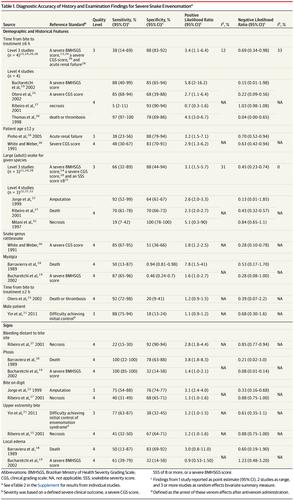当前位置:
X-MOL 学术
›
JAMA Surg.
›
论文详情
Our official English website, www.x-mol.net, welcomes your
feedback! (Note: you will need to create a separate account there.)
Does This Patient Have a Severe Snake Envenomation?: The Rational Clinical Examination Systematic Review.
JAMA Surgery ( IF 15.7 ) Pub Date : 2019-04-01 , DOI: 10.1001/jamasurg.2018.5069 Charles J Gerardo 1 , João R N Vissoci 1 , C Scott Evans 2 , David L Simel 3, 4 , Eric J Lavonas 5, 6
JAMA Surgery ( IF 15.7 ) Pub Date : 2019-04-01 , DOI: 10.1001/jamasurg.2018.5069 Charles J Gerardo 1 , João R N Vissoci 1 , C Scott Evans 2 , David L Simel 3, 4 , Eric J Lavonas 5, 6
Affiliation

|
Importance
Venomous snakebite severity ranges from an asymptomatic dry bite to severe envenomation and death. The clinical evaluation aids in prognosis and is essential to determine the risks and potential benefits of antivenom treatment.
Objectives
To identify historical features, clinical examination findings, basic laboratory testing, and clinical grading scales that will risk-stratify patients with pit viper snake envenomation for severe systemic envenomation, severe tissue injury, and/or severe hematologic venom effects.
Data Sources
We conducted a structured search of PubMed (1966-October 3, 2017) and Embase database (1980-October 3, 2017) to identify English-language studies that evaluated clinical features predictive of severe envenomation.
Study Selection
We included studies that evaluated the test performance of at least 1 clinical finding with an acceptable reference standard of severe envenomation for venomous snakes of the Western Hemisphere. Only studies involving the most common subfamily, Crotalinae (pit vipers), were evaluated. Seventeen studies with data were available for abstraction.
Data Extraction and Synthesis
The clinical features assessed and severity outcome measures were extracted from each original study. We assessed severity in 3 categories: systemic toxicity, tissue injury, and hematologic effects. Differences were resolved by author consensus.
Results
The pooled prevalence of severe systemic envenomation was 14% (95% CI, 9%-21%). The pooled prevalence of severe tissue injury and severe hematologic venom effects were 14% (95% CI, 12%-16%) and 18% (95% CI, 8%-27%), respectively. Factors increasing the likelihood of severe systemic envenomation included the time from bite to care of 6 or more hours (likelihood ratio [LR], 3.4 [95% CI, 1.1-6.4]), a patient younger than 12 years (LRs, 3.2 [95% CI, 1.5-7.1] and 2.9 [95% CI, 1.3-6.2]), large snake size (LR, 3.1 [95% CI, 1.5-5.7]), and ptosis (LRs, 1.4 [95% CI, 1.0-2.1] and 3.8 [95% CI, 1.8-8.3]). Envenomation by the genus Agkistrodon (copperhead and cottonmouth), as opposed to rattlesnakes, decreased the likelihood of severe systemic envenomation (LR, 0.28 [95% CI, 0.10-0.78]). Initial hypofibrinogenemia (LR, 5.1 [95% CI, 1.7-15.0]) and thrombocytopenia (LR, 3.7 [95% CI, 1.9-7.3]) increased the likelihood of severe hematologic venom effects. Other clinical features from history, physical examination, or normal laboratory values were not discriminative.
Conclusions
Clinical features can identify patients at increased risk of severe systemic envenomation and severe hematologic venom effects, but there are few features that are associated with severe tissue injury or can confidently exclude severe envenomation. Physicians should monitor patients closely and be wary of progression from nonsevere to a severe envenomation and have a low threshold to escalate therapy as needed.
中文翻译:

该患者有严重的蛇毒吗?:合理的临床检查系统评价。
重要性毒蛇咬伤的严重程度从无症状的干伤到严重的毒死和死亡。临床评估有助于预后,对于确定抗蛇毒治疗的风险和潜在益处至关重要。目的确定病史,临床检查结果,基本的实验室检查和临床分级量表,这些风险量表将对-蛇蛇毒化患者进行严重的全身性毒化,严重的组织损伤和/或严重的血液毒液影响。数据来源我们对PubMed(1966年10月3日,2017年10月3日)和Embase数据库(1980年10月3日,2017年10月)进行了结构化搜索,以鉴定评估临床表现可预测严重毒化的英语研究。研究选择我们纳入的研究评估了至少一项临床发现的测试性能,并采用了可接受的西半球有毒蛇的严重毒害参考标准。仅评估了涉及最常见的亚科(猪tal属)的研究。十七项研究的数据可用于抽象。数据提取和综合从每个原始研究中提取评估的临床特征和严重程度结果指标。我们评估了3类严重程度:全身毒性,组织损伤和血液学影响。差异通过作者的共识解决。结果严重全身性感染的合并患病率为14%(95%CI,9%-21%)。严重组织损伤和严重血液毒液作用的合并患病率分别为14%(95%CI,12%-16%)和18%(95%CI,8%-27%)。导致严重全身性感染的可能性增加的因素包括从咬伤到护理的时间超过6小时(可能性比[LR],3.4 [95%CI,1.1-6.4]),小于12岁的患者(LR,3.2 [ 95%CI(1.5-7.1)和2.9 [95%CI,1.3-6.2]),大蛇形(LR,3.1 [95%CI,1.5-5.7])和上睑下垂(LRs,1.4 [95%CI, 1.0-2.1]和3.8 [95%CI,1.8-8.3]。与响尾蛇相反,Agkistrodon属(铜头和棉嘴)的毒化作用降低了发生严重全身性毒化的可能性(LR,0.28 [95%CI,0.10-0.78])。最初的低纤维蛋白原血症(LR,5.1 [95%CI,1.7-15.0])和血小板减少症(LR,3.7 [95%CI,1.9-7.3])增加了严重血液毒物作用的可能性。根据病史,体格检查或正常实验室检查值得出的其他临床特征无差别。结论临床特征可以识别出发生严重全身性毒化和严重血液学毒副作用的风险较高的患者,但很少有与严重组织损伤有关或可以肯定地排除严重毒化作用的特征。医师应密切监视患者,并警惕从严重到严重的病情发展,并根据需要降低治疗门槛。
更新日期:2019-04-20
中文翻译:

该患者有严重的蛇毒吗?:合理的临床检查系统评价。
重要性毒蛇咬伤的严重程度从无症状的干伤到严重的毒死和死亡。临床评估有助于预后,对于确定抗蛇毒治疗的风险和潜在益处至关重要。目的确定病史,临床检查结果,基本的实验室检查和临床分级量表,这些风险量表将对-蛇蛇毒化患者进行严重的全身性毒化,严重的组织损伤和/或严重的血液毒液影响。数据来源我们对PubMed(1966年10月3日,2017年10月3日)和Embase数据库(1980年10月3日,2017年10月)进行了结构化搜索,以鉴定评估临床表现可预测严重毒化的英语研究。研究选择我们纳入的研究评估了至少一项临床发现的测试性能,并采用了可接受的西半球有毒蛇的严重毒害参考标准。仅评估了涉及最常见的亚科(猪tal属)的研究。十七项研究的数据可用于抽象。数据提取和综合从每个原始研究中提取评估的临床特征和严重程度结果指标。我们评估了3类严重程度:全身毒性,组织损伤和血液学影响。差异通过作者的共识解决。结果严重全身性感染的合并患病率为14%(95%CI,9%-21%)。严重组织损伤和严重血液毒液作用的合并患病率分别为14%(95%CI,12%-16%)和18%(95%CI,8%-27%)。导致严重全身性感染的可能性增加的因素包括从咬伤到护理的时间超过6小时(可能性比[LR],3.4 [95%CI,1.1-6.4]),小于12岁的患者(LR,3.2 [ 95%CI(1.5-7.1)和2.9 [95%CI,1.3-6.2]),大蛇形(LR,3.1 [95%CI,1.5-5.7])和上睑下垂(LRs,1.4 [95%CI, 1.0-2.1]和3.8 [95%CI,1.8-8.3]。与响尾蛇相反,Agkistrodon属(铜头和棉嘴)的毒化作用降低了发生严重全身性毒化的可能性(LR,0.28 [95%CI,0.10-0.78])。最初的低纤维蛋白原血症(LR,5.1 [95%CI,1.7-15.0])和血小板减少症(LR,3.7 [95%CI,1.9-7.3])增加了严重血液毒物作用的可能性。根据病史,体格检查或正常实验室检查值得出的其他临床特征无差别。结论临床特征可以识别出发生严重全身性毒化和严重血液学毒副作用的风险较高的患者,但很少有与严重组织损伤有关或可以肯定地排除严重毒化作用的特征。医师应密切监视患者,并警惕从严重到严重的病情发展,并根据需要降低治疗门槛。











































 京公网安备 11010802027423号
京公网安备 11010802027423号